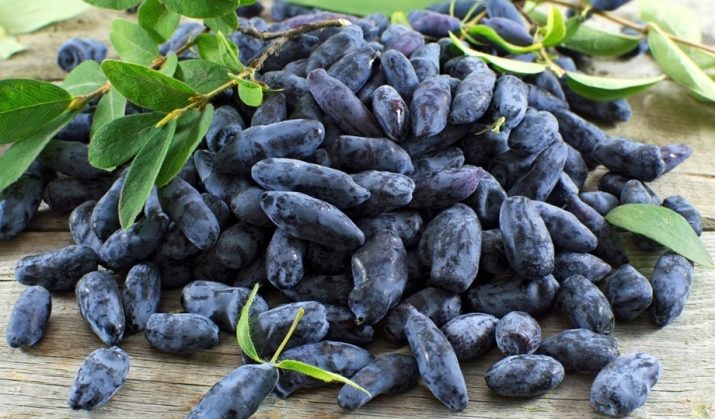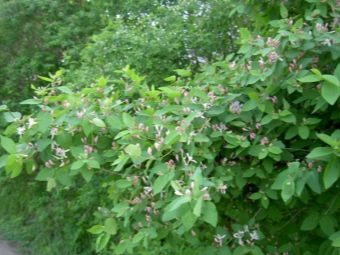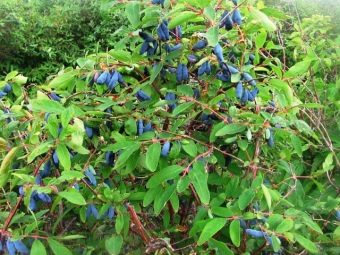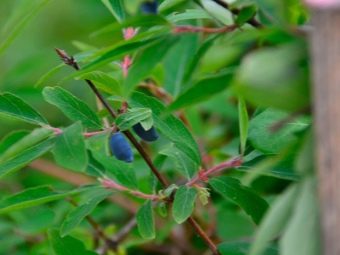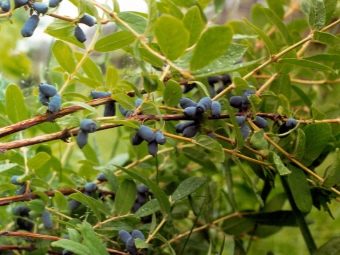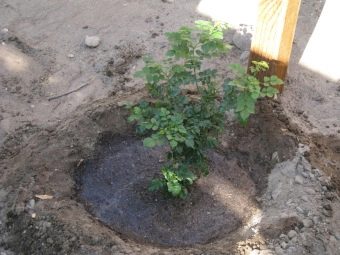How to grow honeysuckle in the Urals?
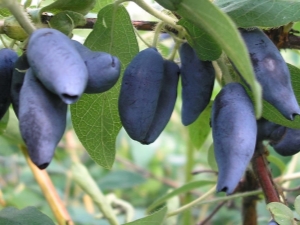
Shrubs are no less important in private farming than fruit trees or fragrant herbs.Especially good are those of them that combine taste and decorative qualities. That is what honeysuckle is.
Features of the plant
Perennial culture gives bright blue berries, different non-standard taste and a huge amount of nutrients and vitamins. Honeysuckle is characterized by endurance in adverse conditions. In addition, it can become a true decoration of the homestead territories. Therefore, it is quite natural that gardeners from various regions of the country show interest in it.
For a long time, it was believed that planting honeysuckle in the Urals does not bring serious results. This opinion is formed because this culture is already growing in the wild. Therefore, they limited themselves to simply collecting ready-made shrubs and transplanting them into home soil. But after several successful experiments, it became clear that cultural honeysuckle tolerates harsh conditions. She calmly survived several times frosts of 35 and even 40 degrees, clearly destroying the positions of skeptics.
No wonder: berry bush optimally feels in cold places. Moreover, just in the southern regions it is much harder to enter the culture. The ease and ease of care, along with a decent potential result, make honeysuckle an increasingly frequent guest in the gardens of the Urals. However, knowledge of the main features of the plant and the rules of its cultivation is very important. Especially for those who want to get a stable perennial plantings.
Botanical properties of culture
In most cases, you can find blue or edible honeysuckle in the gardens: these two species produce a harvest of pleasant-tasting and healthy berries.
The main features are as follows:
- height - up to 100-250 cm;
- covering the stems with yellow, sometimes reddish bark;
- crown in the form of a small ball;
- foliage, similar to an ellipse or lancet;
- flowers in the shape of a funnel, differing in color depending on the subspecies.
Honeysuckle blooms in the last days of May or in early June. Inflorescences survive well frost in the spring. Berry picking is possible before the onset of autumn cold. You can count on the harvest from 4-5 years of cultivation. The duration of development in one place without updating the plantings can reach 8 decades.
Such advantages mean that you really should pay close attention to this shrub.
Recommended varieties
In the list of the best varieties for the Urals guaranteed to secure a place "titmouse". She was brought out by combining the best qualities of crops grown in Siberia, in various areas of the Far East and in the Urals itself. Shrubs are high (sometimes up to 2 m). Despite strong development, the form is always compact, round, the taste is intermediate: from sour to sweet. The advantages of the variety are the low risk of premature shedding and early development.
The blue bird ripens very early, around mid-June. The fertility of planting is average: from a bush for a season it is possible to collect up to 2 kg of cylindrical berries. The plant tolerates temperature fluctuations well, but ripe berries can crumble.
The Blue Spindle manifests itself even worse in terms of this indicator. Despite this fact, as well as the likelihood of getting a bitter crop with low moisture, the variety is valued for good immunity to cold winters.
"Nymph" gives quite a few branches, the height of the bush does not exceed 180 cm. The resistance to cold also allows you to survive the vagaries of the Ural climate. Large berries "Nymphs" slightly curved.
If it is critically important for gardeners that the crop does not crumble, they should choose the “Bazhovskaya” variety. No wonder she was recognized as one of the best middle-late varieties, in addition to giving sweet berries.
Speaking about other types, it is worth noting:
- "Mary";
- "Amazon";
- Kamchadalka;
- "Chosen One";
- "Yugan".
How to plant?
Any variety will give a high result only with scrupulous execution of the norms of agricultural technology.In the Urals, all the same methods of cultivating berry bushes are possible as in other regions of the country. It is recommended to choose vegetative variants at the same time, because cultivation from seeds is too laborious and takes excessive time. It is advisable to harvest cuttings as soon as the fruits begin to ripen. Usually this moment comes in the middle of May.
To dissolve the honeysuckle seedlings, it will take green shoots of the first year of life. Cut cuttings with a length of 100-120 mm each, be sure to ensure that each has 3 buds. The probability of success is higher when harvesting cuttings with the “heel”. The upper cut must be straight, each stalk must be treated before planting the growth accelerator.
The full development of the seedling is possible in a tank made of wood filled with river sand (which is required to be washed out).
Experts advise after planting to cover the container with a film to create a miniature greenhouse. In addition to watering and illumination with indirect sunlight, systematic airing should be carried out. Rooted cuttings on average for 14-17 days. They should be planted in the fall. This approach allows us to achieve almost guaranteed success.
Correct planting is not only choosing a specific method and complying with the norms of agricultural engineering. It is extremely important to select the best planting material. All varieties that are not regionalized for the Urals or more severe regions should be left without mercy. The maximum large and high-quality crop with a guarantee can be obtained by planting honeysuckle several varieties at once. Attention should be paid to the health of purchased seedlings and the presence of accompanying documentation.
Peeling bark for honeysuckle - in the order of things. It is recommended to plant it in heavy soils with a well-developed structure. Ideal clay and loam, but always with decent moisture. A good result is obtained on fertile land with additional feeding. Almost all varieties grow on sun-drenched sites, only a few species are able to survive a little shading.
Saplings with open roots move to the ground at the turn of spring and summer. But container plants are required to be planted 30 days or so before the expected frosts. The pit for planting in the spring, in any case, is dug up and loosened, saturated with mineral compounds. During the season, loosening is carried out constantly. It is very good if there is a drainage layer of small natural stone or brick combat below.
It is categorically unacceptable to introduce fertilizer at the root after planting. But mulching pristvolnogo circle is welcome.
Ideal coatings are:
- needles;
- peat;
- sphagnum;
- last year's grass.
Care
Honeysuckle hostile to overwetting. But at the same time, it should not be left dry, especially during the hot summer period. The rate of watering on one bush - 20 liters of water. Fluid is critical during flowering and when the fruit will ripen. It is enough to miss at least one of these moments, and the magnitude of the harvest will be reduced by at least 50%.
Top dressing in the first year is not carried out, but from the second it becomes an obligatory matter. Along the external border of the trunk circle, they dig a groove and introduce fertilizer through it. If you do not comply with this rule, with the hope of getting the berries before the winter will have to leave. Of great importance is the regulation of the development of the crown, since its density is inversely opposite to the number of berries harvested. Pruning is carried out from the third year of development, be sure to remove any damaged branch, and healthy shoots are shortened to 200 mm, completely exposing the lower part.
Cut off the affected shoots and on the eve of winter. Otherwise, they are a great help for infections. Hilling ground grass branches is also required. If you follow these simple requirements, you can get a large fortified crop.
It is worth paying attention to what to feed the plants.
About fertilizers and not only
For honeysuckle are important a variety of feedings:
- nitrogen (to improve the quality of the soil);
- phosphoric (responsible for the decorative qualities of the culture);
- potash (helping the plant's body to grow);
- organic (without it, the absorption of minerals will be incomplete).
Watering the honeysuckle is possible for the whole plant completely. But it should be sprayed only in the early and late hours of the day. Top dressing is carried out twice a month, and primacy belongs to nitrogen mixtures - you need to catch up with them before flowering. After flowering is completed, fertilizing is organized with a combination of nitrogen and phosphorus (3-5 liters of solution of normal concentration per bush). 15 g of potassium salt per 1 sq. m, often use humus and vegetable compost.
Rejuvenation of the bushes is carried out every 3-6 years. The ripeness of the fruit is assessed for their achievement of a dark blue color. If you open the ripe berries, red flesh is found.
In the case of powdery mildew, the sick parts will have to be removed, since they will forever remain infected. For the same reason, it is necessary to burn the leaves affected by ascochyte spotting.
Learn more about how to grow honeysuckle in the Urals, you will learn from the following video.

